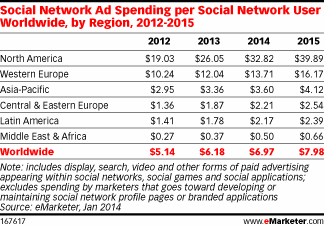When venture capital firm Andreessen Horowitz put $50 million into BuzzFeed earlier this week, it put the rest of the media world on notice. Not that there's a permanent shift to "listicles" (articles built on lists) or celebrity gawking, but that there is a move toward socially driven content.
"We're presently in the midst of a major technological shift in which, increasingly, news and entertainment are being distributed on social networks and consumed on mobile devices," General Partner Chris Dixon wrote in a blog post explaining Andreessen Horowitz's investment. "We believe BuzzFeed will emerge from this period as a preeminent media company."
Think about what he's arguing for a minute.
If the new standard is how well content plays on social media and mobile devices -- and by "content," I mean anything that exists to help tell a story: photos, charts, videos, and, of course, articles -- then we've been missing the real value of social media and vastly underestimating the market potential for Facebook (FB +1.47%), Twitter (TWTR +0.00%), and Google (GOOGL +2.01%)(GOOG +1.97%) via YouTube.
Social media distribution: A new model
Certainly, BuzzFeed will profit, too. But if the point is that content is now largely designed for, and delivered to, mobile devices via social filters, then the primary networks of our day are a bit like the television networks of old.
Twenty years ago, only the earliest of early adopters tried to get televised content from anywhere but one of the major cable providers. Your viewing options were determined by the "package" you purchased, which included a specified number of channels, each featuring some amount of programming.
Social media acts as this sort of filter for us online. What we see in our social feeds influences our decisions about what to read, watch, and listen to. Consider these statistics:
-
In 2012, when the site hadn't yet cracked the billion-monthly user mark, Facebook was processing 2.5 billion pieces of content daily. Its user base is now up 38%, and it processes more than 4.75 billion content items per day.
-
According to a March study commissioned by Twitter and Twenty-First Century Fox, 76% of users who recalled seeing a TV-related tweet later searched for the show in question.
-
And most recently, a July survey from Variety found that all five of the most influential figures among Americans aged 13-18 are YouTube stars. Among "real-world" celebrities, the late Paul Walker ranked sixth, followed by Jennifer Lawrence at seventh.
Social media isn't just tracking the zeitgeist. It is the zeitgeist.
A sizable opportunity
What can investors expect? According to eMarketer, social media ad spending is already on the rise around the world. North America is leading the way:

Would growth accelerate if more dollars shifted from traditional TV advertising? It may already be happening. According to eMarketer, YouTube was on track to keep $1.96 billion of the $5.6 billion spent to advertise on the platform -- a 65.5% year-over-year increase.
Yet there's more room to grow. According to AdWeek, the TV industry accounts for $74 billion in revenue in the U.S. alone. Capturing even 10% of that total would not only be a huge catalyst for YouTube but also Facebook, which, as the world's largest social media platform, is on pace to produce about $11 billion in 2014 revenue. Advertising accounted for 91.9% of Facebook's second-quarter revenue.
For its part, Twitter produced $277.4 million in ad revenue in the latest quarter -- 88.9% of its total. That gulf could widen in future years as more clients hire the microblogger to distribute content and apps. Existing deals with Comcast and British Sky Broadcasting to connect viewers to programming in real time could serve as a template.
Foolish takeaway
Whatever form it takes, there's an undeniable shift toward using social media for engagement. Presuming that won't also lead to a significant shift in ad spending would be folly. When it does -- when Madison Avenue fully embraces social advertising -- it'll be the ad-dependent platforms such as Facebook, Twitter, and Google (via YouTube) that cash in first. Keep a close watch on those stocks.








